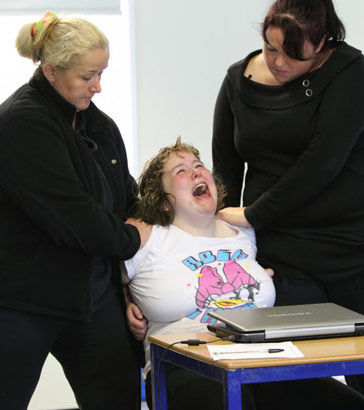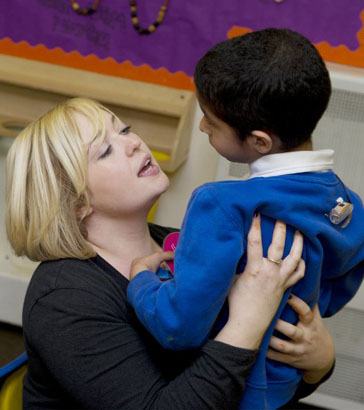
Since those with PMLD were first formally involved in
education in 1970, considerable time and
effort has been expended on discussing pupil voice. School councils have
often been mentioned, as in mainstream schools, but this would clearly be
entirely tokenistic in special schools. Nonetheless, investing time in teaching
those with PMLD to have a proactive voice, to be fully contingently
aware in an interpersonal
sense – 'My actions can have an effect upon you' – is time well spent.
It must be remembered, however, that pupil voices should have the right
to say no as well as yes. Wilkinson (1994) refers to issues of control.
It will be necessary to teach how and when they might gain that control.

Issues of control are especially important for those who are not in control
of their own lives, but who by necessity have others managing it. (Barber,
1994; Wilkinson, 1994; Collis and Lacey, 1996; Hewett and Nind, 1998; Imray, 2008).
This will naturally involve a great deal of sensitivity and reflection by
teachers with the central question of 'Am I doing the right thing?' always
to the fore. Teaching those with PMLD is particularly challenging
simply because it is so easy for the teacher
to take control, to be didactic, and to limit learning rather than expand it.

Perhaps the easiest way to avoid being didactic is to ask another question: 'Have
I taught my pupils how to say no?' The ability to say no and for that no
to be acted upon is something we all take for granted. But can the same
be said for those with PMLD?
This goes hand in hand with teaching contingency awareness. The issue of
control over everyday issues is a classic example of the holistic approach
so strongly argued for in Routes for Learning (2006). There are many times
when learners will not want to do things, touch things, taste things, be
in certain places. If we are to teach the ability to say no, it is essential
that learners are listened to and that their no is acted upon (Rawling,
Dowse and Shaddock, 1995).

Particular attention has to be given to knowing and listening to those with PMLD. Ware (2003) argues very strongly that it is not sufficient just to know the child, since there is a strong tendency in caregiver/child interactions for:
- The person with PMLD to be the passive partner;
- The caregiver to be the dominant partner;
- Comparatively few responses to be received from their caregivers;
- Clashes between the person with PMLD and the caregiver
(ie where both are 'speaking'
at once).

Barber, M. (1994) Contingency Awareness: Putting Research into the Classroom
in Coupe O'Kane, J. and Smith, B. (eds) Taking Control. London. David Fulton.
Collis, M. and Lacey, P, (1996). Interactive Approaches to Teaching. London.
David Fulton.
Hewett, D, and Nind, M, (1998) Interaction in Action. London. David Fulton.
Imray, P. (2008) Turning the Tables on Challenging Behaviour. London. Routledge.
Miller, J. (1998) Personal Needs and Independence in Lacey, P, and Ouvry, C. People with Profound and Multiple Learning
Disabilities. London. David Fulton.

Rawlingsm, M., Dowse, L., and Shaddock, A. (1995) Increasing the involvement
of people with an intellectual disability in choice making situations: a
practical approach. International Journal of Disability and Developmental
Education. 42; pp137-153.
Routes for Learning (2006). Qualifications and Curriculum Group.
DfE. Cardiff.
Ware, J. (2003) Creating a Responsive Environment.
London. David Fulton.
Wilkinson, C. (1994) Teaching Pupils with Profound and Multiple Learning Difficulties
to Exert Control in Coupe O'Kane J and
Smith B (eds) Taking Control.
London. David Fulton